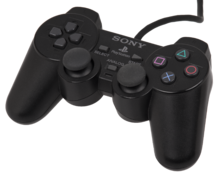DualShock series and Sixaxis
Released in 1998, the DualShock controller for the PlayStation succeeded its predecessor, the Dual Analog, and would go on to become the longest running series of controllers for the PlayStation brand. In addition to the inputs of the original, digital, controller ( ,
,  ,
,  ,
,  , L1, L2, R1, R2, Start, Select and a D-pad), the DualShock featured two analog sticks in a similar fashion to the previous Dual Analog controller, which can also be depressed to activate the L3 and R3 buttons.[119]
, L1, L2, R1, R2, Start, Select and a D-pad), the DualShock featured two analog sticks in a similar fashion to the previous Dual Analog controller, which can also be depressed to activate the L3 and R3 buttons.[119]
The DualShock series consists of three controllers: the DualShock which was the fourth controller released for the PlayStation; the DualShock 2, the only standard controller released of the PlayStation 2, and the DualShock 3, the second and current controller released for the PlayStation 3. The Sixaxis was the first official controller for the PlayStation 3, and is based on the same design as the DualShock series (but lacking the vibration motors of the DualShock series of controllers).
Like the Dual Analog, the DualShock and DualShock 2 feature an "Analog" button between the analog sticks that toggles the analog sticks on and off (for use with games which support only the digital input of the original controller). On the PlayStation 3 Sixaxis and DualShock 3 controllers, the analog sticks are always enabled. Beginning with the Sixaxis, a 'PlayStation button' (which featured the incorporated PS logo and is similar in function to theXbox 360 "Guide" button) was included on controllers. The PlayStation button replaces the "Analog" button of the DualShock and DualShock 2 controllers. Pressing the PS button on the PS3 brings up the XMB, while holding it down brings up system options (such as quit the game, change controller settings, turn off the system, and turn off the controller).[120]










0 komentar:
Posting Komentar